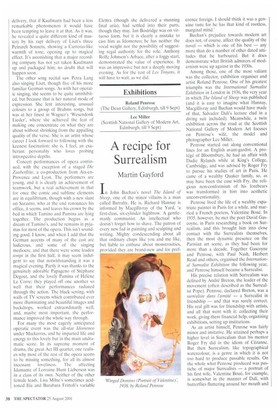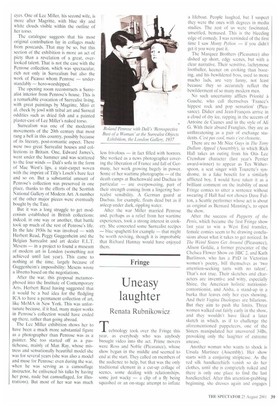Roland Penrose (The Dean Gallery. Edinburgh, till 9 Sept) Lee
Miller (Scottish National Gallery of Modern Art, Edinburgh. till 9 Sept)
A recipe for Surrealism
Martin Gayford
In John Buchan's novel The Island of Sheep, one of the minor villains is a man called Barralty. He is, Richard Hannay is informed by Macgillivray of the Yard, 'a first-class, six-cylinder highbrow. A gentlemanly communist. An intellectual who doesn't forget how to shave. The patron of every new fad in painting and sculpting and writing. Mighty condescending about all that ordinary chaps like you and me like, but liable to enthuse about monstrosities, provided they are brand-new and for pref
erence foreign. I should think it was a genuine taste for he has that kind of rootless, marginal mind.'
Buchan's prejudice towards modern art does not, of course, affect the quality of the novel — which is one of his best — any more than do a number of other dated attitudes that he harboured. But it does demonstrate what British admirers of modernism were up against in the 1930s.
Among those, one of the most valiant was the collector, exhibition organiser and artist Roland Penrose. One of his greatest triumphs was the International Surrealist Exhibition in London in 1936, the very year in which The Island of Sheep was published (and it is easy to imagine what Hannay, Macgillivray and Buchan would have made of that, Salvador Dail's lecture clad in a diving suit included). Meanwhile, a twin exhibition across the road at the Scottish National Gallery of Modern Art focuses on Penrose's wife, the model and photographer Lee Miller.
Penrose started out along conventional lines for an English avant-gardist. A protégé of Bloomsbury, he had an affair with Dadie Rylands while at King's College, Cambridge, and was advised by Roger Fry to pursue his studies of art in Paris. He came of a wealthy Quaker family, so, as may have been the case with Fry, the religious non-conformism of his forebears was transformed in him into aesthetic unconventionality.
Penrose lived the life of a wealthy expatriate painter in Paris for a while, and married a French poetess, Valentine Boue. In 1935, however, he met the poet David Gascoyne, in Paris researching a book on Surrealism, and this brought him into close contact with the Surrealists themselves, then the most dynamic presence on the Parisian art scene, as they had been for more than a decade. Together Gascoyne and Penrose, with Paul Nash, Herbert Read and others, organised the International Surrealist Exhibition the following year, and Penrose himself became a Surrealist.
His precise relation with Surrealism was defined by Andre Breton, the leader of the movement (often described as the Surrealist Pope). Penrose, declared Breton, was a surrealiste dans l'amitie — a Surrealist in friendship — and that was surely correct. His real gift was for friendship with artists, and all that went with it: collecting their work, giving them financial help, organising exhibitions, setting up institutions.
As an artist himself, Penrose was fairly minor and imitative. He attained perhaps a higher level in Surrealism than his mentor Roger Fry did in the idiom of Cezanne. But then Surrealism, like topographical watercolour, is a genre in which it is not too hard to produce passable results. On the whole what Penrose produced was pastiche of major Surrealists — a portrait of his first wife, Valentine Bowe, for example, is somewhat in the manner of Dalf, with butterflies fluttering around her mouth and eyes. One of Lee Miller, his second wife, is more after Magritte, with blue sky and white clouds visible within the outline of her torso.
The catalogue suggests that his most original contribution lay in collages made from postcards. That may be so, but this section of the exhibition is more an act of piety than a revelation of a great, overlooked talent. That is not the case with the Penrose collection, which was spectacular, rich not only in Surrealism but also the work of Picasso whom Penrose — understandably — hero-worshipped.
The opening room reconstructs a Surrealist interior from Penrose's house. This is a remarkable evocation of Surrealist living, with great paintings by Magritte. Miro et al, cheek by jowl with tribal art and Surreal oddities such as dried fish and a painted plaster-cast of Lee Miller's naked torso.
Surrealism was one of the modernist movements of the 20th century that most rang a bell in this country, possibly because of its literary, post-romantic aspect. There were two great Surrealist houses and collections in Britain. One, Edward James's, went under the hammer and was scattered to the four winds — Dali's sofa in the form of Mae West's lips, a stair-carpet woven with the imprint of Tilly's Losch's bare feet and so on. But a substantial amount of Penrose's collection was preserved in one place, thanks to the efforts of the Scottish National Gallery of Modern Art. A number of the other major pieces were eventually bought by the Tate.
But it was a long struggle to get modernism established in British collections: indeed, in one way or another, that battle took up much of the rest of Penrose's life. In the late 1930s he was involved — with Herbert Read, Peggy Guggenheim and the Belgian Surrealist and art dealer E.L.T. Mesens — in a project to found a museum of modern art in London (something not achieved until last year). This came to nothing at the time, largely because of Guggenheim's impossibility: Mesens wrote a libretto based on the negotiations.
After the war, this proposal metamorphosed into the Institute of Contemporary Arts, Herbert Read having suggested that it would be a had idea for the fledgling ICA to have a permanent collection of art, like MoMA in New York. This was unfortunate because, if it had, many major works in Penrose's collection would have ended up there, rather than going abroad.
The Lee Miller exhibition shows her to have been a much more substantial figure as a photographer than Penrose was as a painter. She too started off as a pasticheuse, mainly of Man Ray, whose mistress and sensationally beautiful model she was for several years (she was also a model and muse for Penrose: even during the war, when he was serving as a camouflage instructor, he enlivened his talks by having her pose, nude but camouflaged, for illustrations). But most of her war was much
less frivolous — in fact filled with horrors. She worked as a news photographer covering the liberation of France and fall of Germany, her work growing hugely in power. Some of her wartime photographs — of the death camps at Buchenwald and Dachau in particular — are overpowering, part of their strength coming from a lingering Surrealist sensibility. A German guard at Dachau, for example, floats dead but as if asleep under dark, rippling water.
After the war Miller married Penrose and, perhaps as a relief from her wartime experiences, took a strong interest in cookery. She concocted some Surrealist recipes — blue spaghetti for example — that might be worth reviving, though it is improbable that Richard Hannay would have enjoyed them.



























































 Previous page
Previous page